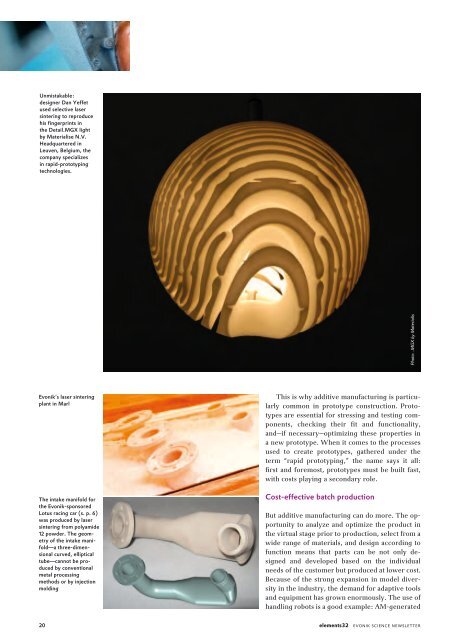Download - Evonik Industries
Download - Evonik Industries
Download - Evonik Industries
Create successful ePaper yourself
Turn your PDF publications into a flip-book with our unique Google optimized e-Paper software.
Unmistakable:<br />
designer Dan yeffet<br />
used selective laser<br />
sintering to repro duce<br />
his fingerprints in<br />
the Detail.MGX light<br />
by Materialise N.V.<br />
Head quartered in<br />
Leuven, Belgium, the<br />
company specializes<br />
in rapid-proto typing<br />
technologies.<br />
<strong>Evonik</strong>‘s laser sintering<br />
plant in Marl<br />
The intake manifold for<br />
the <strong>Evonik</strong>-sponsored<br />
Lotus racing car (s. p. 6)<br />
was produced by laser<br />
sintering from polyamide<br />
12 powder. The geo m-<br />
etry of the intake manifold—a<br />
three-dimen -<br />
sional curved, ellip tical<br />
tube—cannot be pro-<br />
duced by conven tional<br />
metal processing<br />
methods or by injection<br />
molding<br />
This is why additive manufacturing is particularly<br />
common in prototype construction. Prototypes<br />
are essential for stressing and testing components,<br />
checking their fit and functionality,<br />
and—if necessary—optimizing these properties in<br />
a new prototype. When it comes to the processes<br />
used to create prototypes, gathered under the<br />
term “rapid prototyping,” the name says it all:<br />
first and foremost, prototypes must be built fast,<br />
with costs playing a secondary role.<br />
Cost-effective batch production<br />
But additive manufacturing can do more. The opportunity<br />
to analyze and optimize the product in<br />
the virtual stage prior to production, select from a<br />
wide range of materials, and design according to<br />
function means that parts can be not only designed<br />
and developed based on the individual<br />
needs of the customer but produced at lower cost.<br />
Because of the strong expansion in model diversity<br />
in the industry, the demand for adaptive tools<br />
and equipment has grown enormously. The use of<br />
handling robots is a good example: AM-generated<br />
20 elements32 evonik science newsletter<br />
Photo: .MGX by Materialis

















